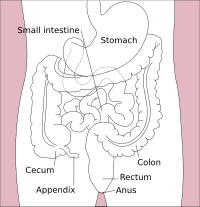
Photo from wikipedia
Background Various patterns of colonic mucosal irregularity have been recorded on contrast enema, each with individually very low sensitivity, but high specificity. Objective To assess the accuracy of the radiologic… Click to show full abstract
Background Various patterns of colonic mucosal irregularity have been recorded on contrast enema, each with individually very low sensitivity, but high specificity. Objective To assess the accuracy of the radiologic features of Hirschsprung disease utilising a unifying stratification of any form of colonic mucosal irregularity on contrast enema. Materials and methods We conducted a retrospective study of children with suspected Hirschsprung disease managed at a tertiary South African hospital from January 2009 through April 2015. Three observers independently reviewed abdominal radiographs and contrast enemas. The enema analysis included a unifying category of any form of colonic mucosal irregularity. Radiologic features were compared with rectal biopsy results. We used descriptive statistics and the Fisher exact test to compare the radiologic features of children with and without Hirschsprung disease. Results Ninety-two children with median age of 37 days (range 3 days to 11 years) were included; 50 had biopsy-proven Hirschsprung disease. On enema, any mucosal irregularity, a transition zone and recto-sigmoid ratio inversion were associated with Hirschsprung disease (all P <0.01). Mucosal irregularity showed 96% sensitivity (95% confidence interval [CI] 86.3–99.5) and 71.4% specificity (CI 55.4–84.3); a transition zone showed 86% sensitivity (CI 73.3–94.2) and 90.5% specificity (CI 77.4–97.3); and recto-sigmoid ratio inversion showed 78% sensitivity (CI 64.0–88.5) and 83.3% specificity (CI 68.3–93.0). Conclusion Colonic mucosal irregularity on contrast enema has high sensitivity and moderate specificity for Hirschsprung disease.
Journal Title: Pediatric Radiology
Year Published: 2020
Link to full text (if available)
Share on Social Media: Sign Up to like & get
recommendations!